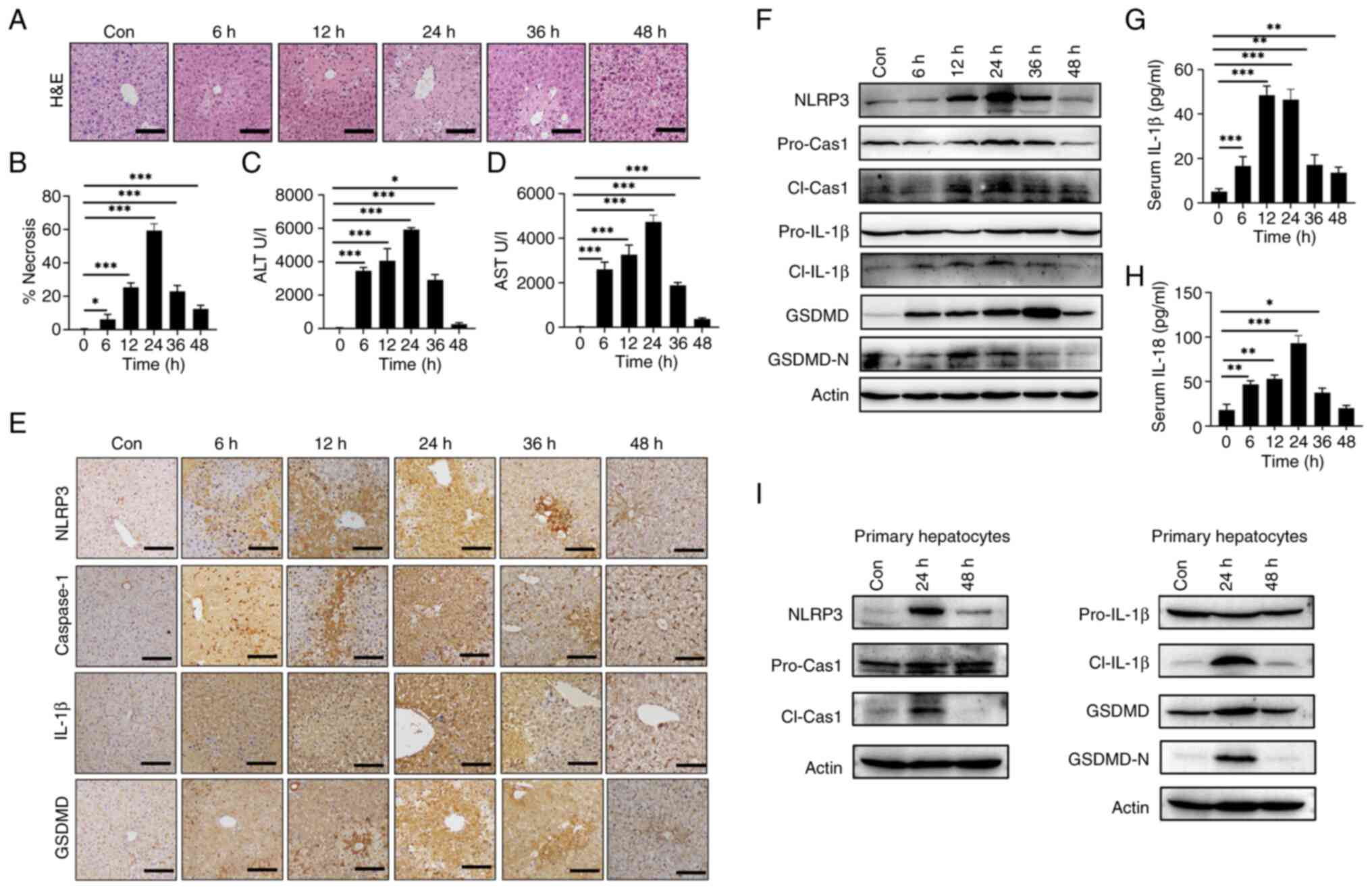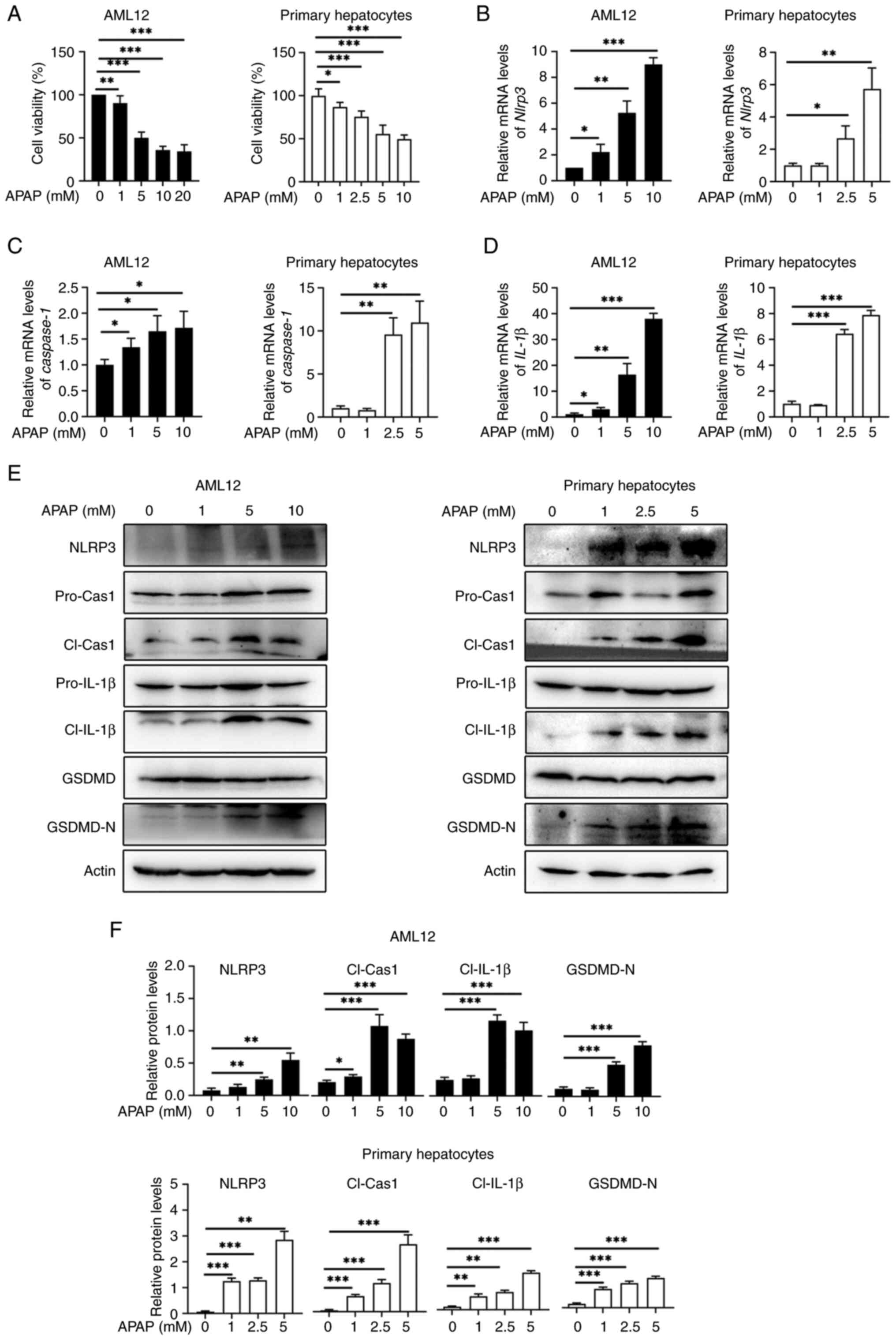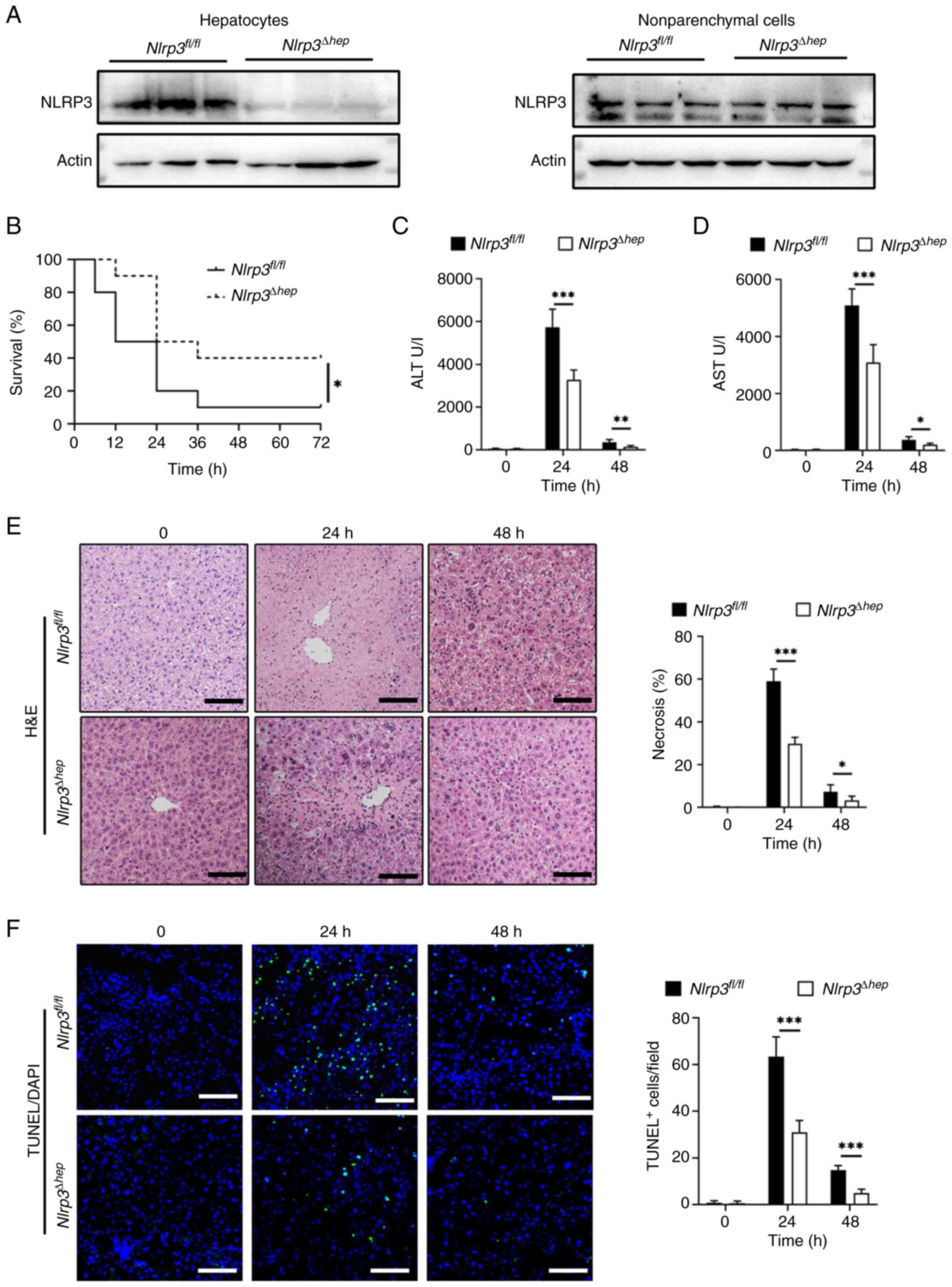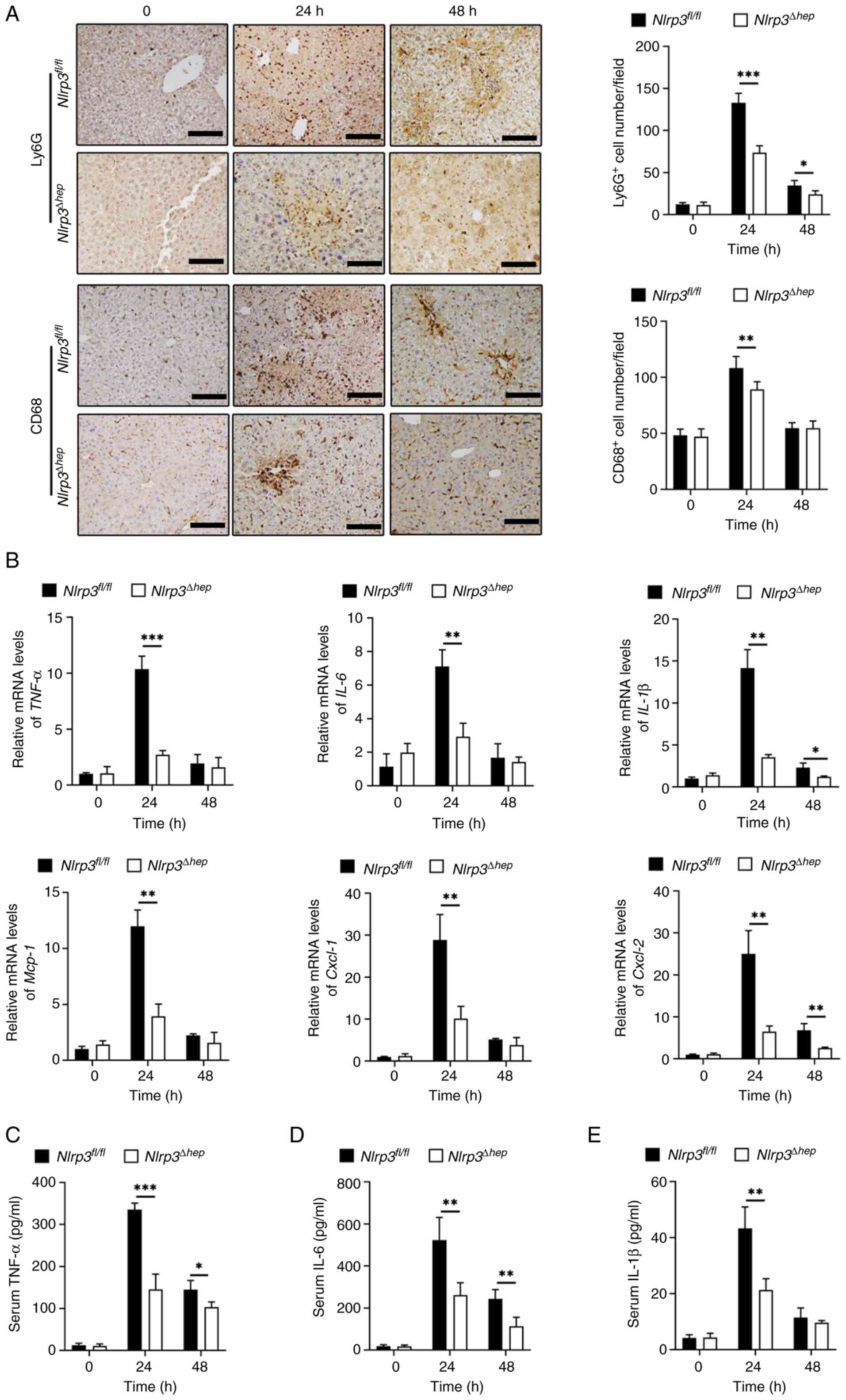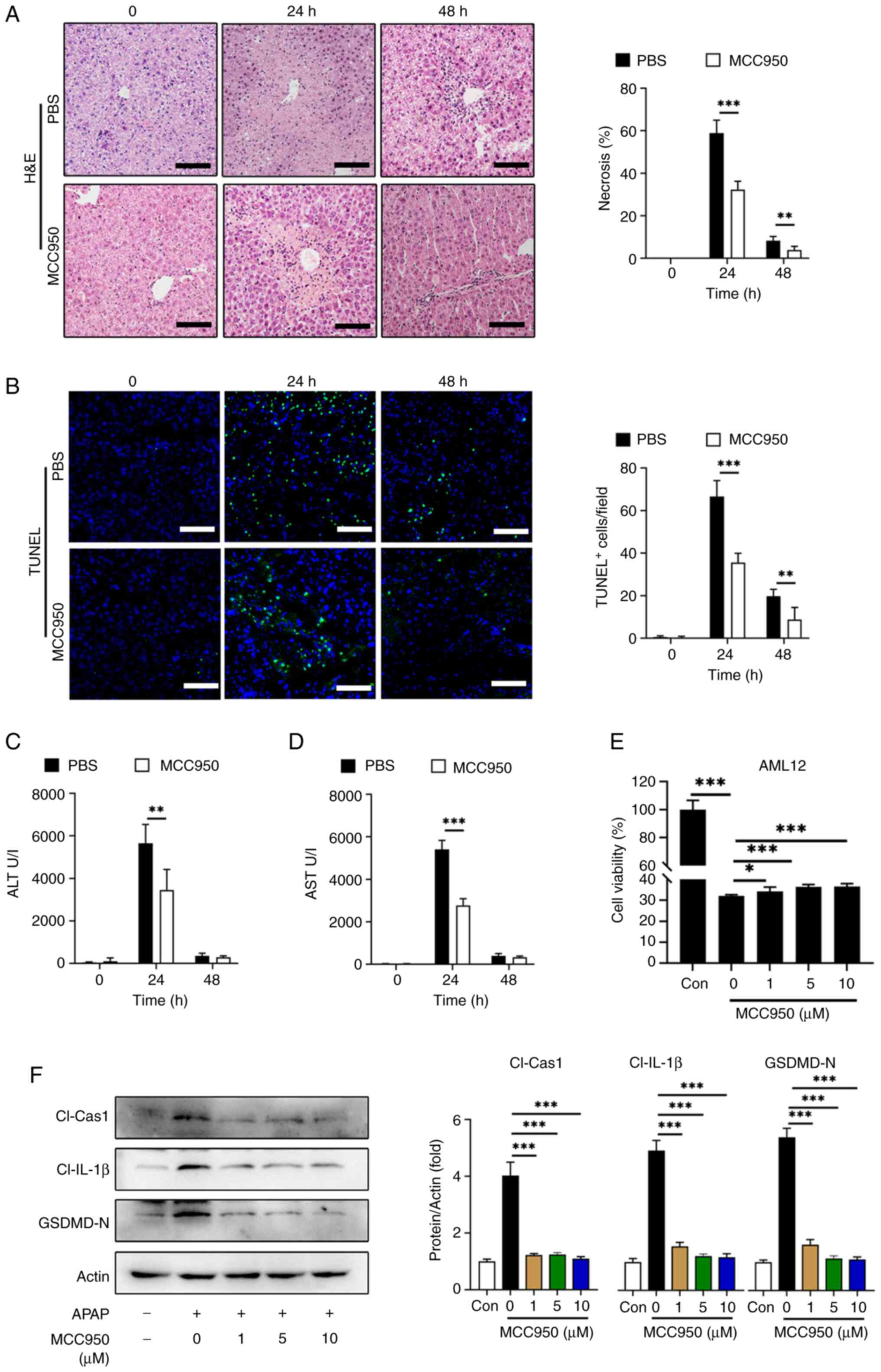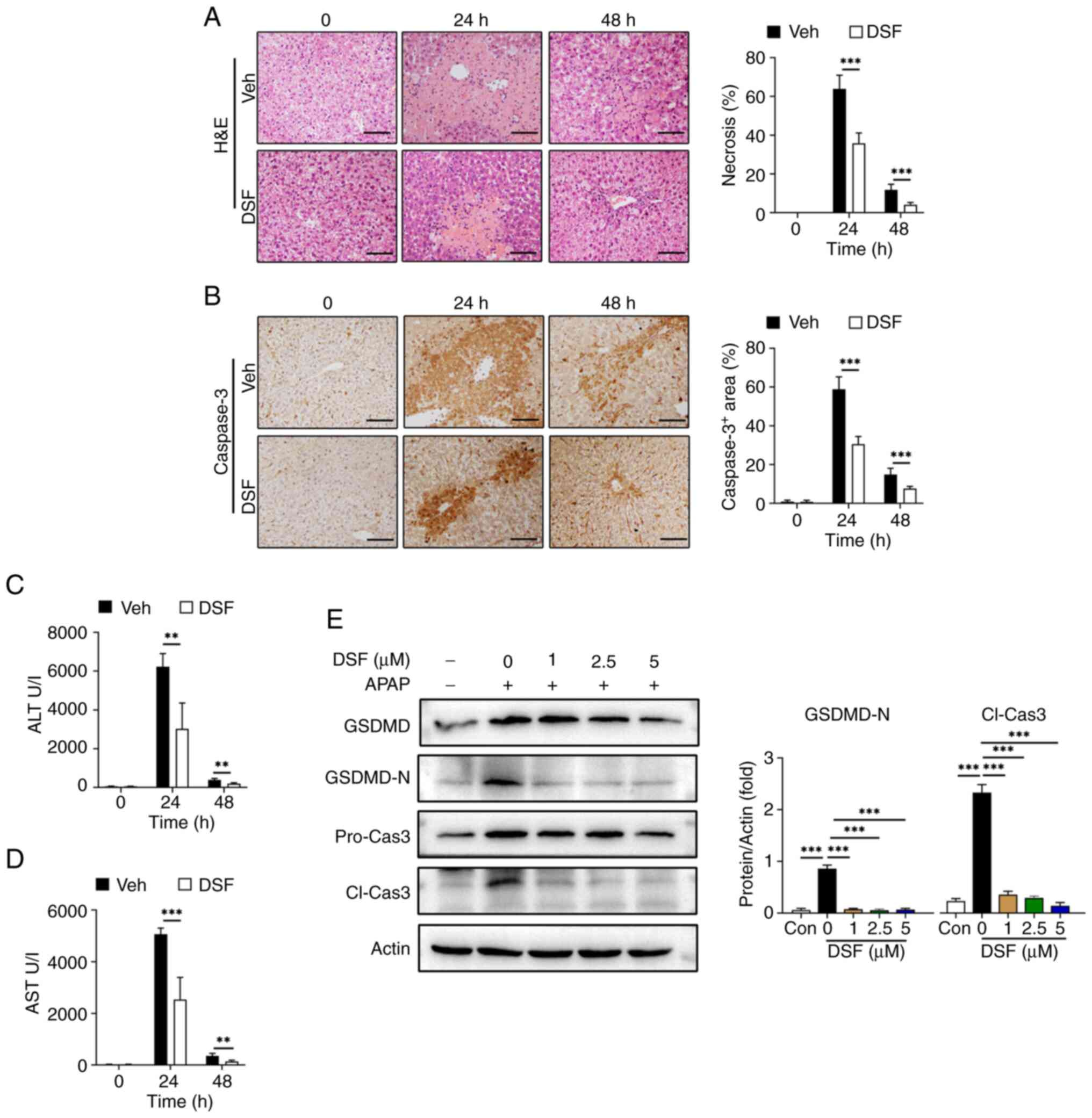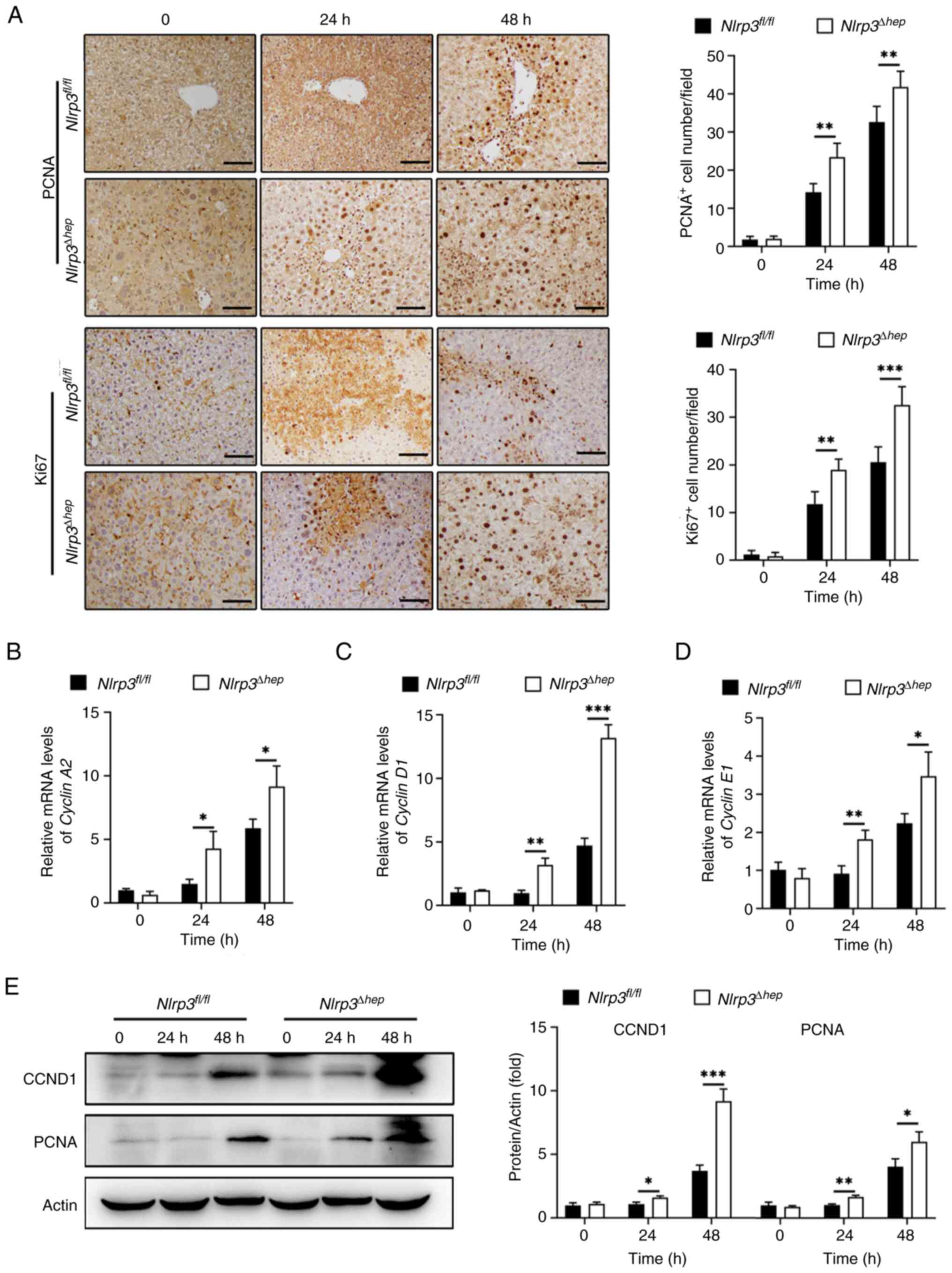|
1
|
Gulmez SE, Larrey D, Pageaux GP, Lignot S,
Lassalle R, Jové J, Gatta A, McCormick PA, Metselaar HJ, Monteiro
E, et al: Transplantation for acute liver failure in patients
exposed to NSAIDs or paracetamol (acetaminophen): The multinational
case-population SALT study. Drug Saf. 36:135–144. 2013. View Article : Google Scholar : PubMed/NCBI
|
|
2
|
Larson AM, Polson J, Fontana RJ, Davern
TJ, Lalani E, Hynan LS, Reisch JS, Schiødt FV, Ostapowicz G, Shakil
AO, et al: Acetaminophen-induced acute liver failure: Results of a
United States multicenter, prospective study. Hepatology.
42:1364–1372. 2005. View Article : Google Scholar : PubMed/NCBI
|
|
3
|
Gow PJ, Jones RM, Dobson JL and Angus PW:
Etiology and outcome of fulminant hepatic failure managed at an
Australian liver transplant unit. J Gastroenterol Hepatol.
19:154–159. 2004. View Article : Google Scholar : PubMed/NCBI
|
|
4
|
Jaeschke H, Adelusi OB, Akakpo JY, Nguyen
NT, Sanchez-Guerrero G, Umbaugh DS, Ding WX and Ramachandran A:
Recommendations for the use of the acetaminophen hepatotoxicity
model for mechanistic studies and how to avoid common pitfalls.
Acta Pharm Sin B. 11:3740–3755. 2021. View Article : Google Scholar : PubMed/NCBI
|
|
5
|
Du K, Ramachandran A and Jaeschke H:
Oxidative stress during acetaminophen hepatotoxicity: Sources,
pathophysiological role and therapeutic potential. Redox Biol.
10:148–156. 2016. View Article : Google Scholar : PubMed/NCBI
|
|
6
|
Bhushan B and Apte U: Liver regeneration
after acetaminophen hepatotoxicity: Mechanisms and therapeutic
opportunities. Am J Pathol. 189:719–729. 2019. View Article : Google Scholar : PubMed/NCBI
|
|
7
|
Jaeschke H, McGill MR and Ramachandran A:
Oxidant stress, mitochondria, and cell death mechanisms in
drug-induced liver injury: Lessons learned from acetaminophen
hepatotoxicity. Drug Metab Rev. 44:88–106. 2012. View Article : Google Scholar : PubMed/NCBI
|
|
8
|
Jaeschke H, Williams CD, Ramachandran A
and Bajt ML: Acetaminophen hepatotoxicity and repair: The role of
sterile inflammation and innate immunity. Liver Int. 32:8–20. 2012.
View Article : Google Scholar : PubMed/NCBI
|
|
9
|
Kubes P and Mehal WZ: Sterile inflammation
in the liver. Gastroenterology. 143:1158–1172. 2012. View Article : Google Scholar : PubMed/NCBI
|
|
10
|
Bajt ML, Knight TR, Farhood A and Jaeschke
H: Scavenging peroxynitrite with glutathione promotes regeneration
and enhances survival during acetaminophen-induced liver injury in
mice. J Pharmacol Exp Ther. 307:67–73. 2003. View Article : Google Scholar : PubMed/NCBI
|
|
11
|
Wang L, Jiao XF, Wu C, Li XQ, Sun HX, Shen
XY, Zhang KZ, Zhao C, Liu L, Wang M, et al: Trimetazidine
attenuates dexamethasone-induced muscle atrophy via inhibiting
NLRP3/GSDMD pathway-mediated pyroptosis. Cell Death Discov.
7:2512021. View Article : Google Scholar : PubMed/NCBI
|
|
12
|
Shi J, Zhao Y, Wang K, Shi X, Wang Y,
Huang H, Zhuang Y, Cai T, Wang F and Shao F: Cleavage of GSDMD by
inflammatory caspases determines pyroptotic cell death. Nature.
526:660–665. 2015. View Article : Google Scholar : PubMed/NCBI
|
|
13
|
Sborgi L, Ruhl S, Mulvihill E, Pipercevic
J, Heilig R, Stahlberg H, Farady CJ, Müller DJ, Broz P and Hiller
S: GSDMD membrane pore formation constitutes the mechanism of
pyroptotic cell death. EMBO J. 35:1766–1778. 2016. View Article : Google Scholar : PubMed/NCBI
|
|
14
|
He WT, Wan H, Hu L, Chen P, Wang X, Huang
Z, Yang ZH, Zhong CQ and Han J: Gasdermin D is an executor of
pyroptosis and required for interleukin-1beta secretion. Cell Res.
25:1285–1298. 2015. View Article : Google Scholar : PubMed/NCBI
|
|
15
|
Yu C, Chen P, Miao L and Di G: The Role of
the NLRP3 inflammasome and programmed cell death in acute liver
injury. Int J Mol Sci. 24:30672023. View Article : Google Scholar : PubMed/NCBI
|
|
16
|
Yang W, Tao K, Zhang P, Chen X, Sun X and
Li R: Maresin 1 protects against
lipopolysaccharide/d-galactosamine-induced acute liver injury by
inhibiting macrophage pyroptosis and inflammatory response. Biochem
Pharmacol. 195:1148632022. View Article : Google Scholar : PubMed/NCBI
|
|
17
|
Han D, Kim H, Kim S, Le QA, Han SY, Bae J,
Shin HW, Kang HG, Han KH, Shin J and Park HW: Sestrin2 protects
against cholestatic liver injury by inhibiting endoplasmic
reticulum stress and NLRP3 inflammasome-mediated pyroptosis. Exp
Mol Med. 54:239–251. 2022. View Article : Google Scholar : PubMed/NCBI
|
|
18
|
Ruan S, Han C, Sheng Y, Wang J, Zhou X,
Guan Q, Li W, Zhang C and Yang Y: Antcin A alleviates pyroptosis
and inflammatory response in Kupffercells of non-alcoholic fatty
liver disease by targeting NLRP3. Int Immunopharmacol.
100:1081262021. View Article : Google Scholar : PubMed/NCBI
|
|
19
|
Liu T, Yang L, Gao H, Zhuo Y, Tu Z, Wang
Y, Xun J, Zhang Q, Zhang L and Wang X: 3,4-dihydroxyphenylethyl
alcohol glycoside reduces acetaminophen-induced acute liver failure
in mice by inhibiting hepatocyte ferroptosis and pyroptosis. PeerJ.
10:e130822022. View Article : Google Scholar : PubMed/NCBI
|
|
20
|
Wang Y, Zhao Y, Wang Z, Sun R, Zou B, Li
R, Liu D, Lin M, Zhou J, Ning S, et al: Peroxiredoxin 3 inhibits
acetaminophen-induced liver pyroptosis through the regulation of
mitochondrial ROS. Front Immunol. 12:6527822021. View Article : Google Scholar : PubMed/NCBI
|
|
21
|
Wang JC, Shi Q, Zhou Q, Zhang LL, Qiu YP,
Lou DY, Zhou LQ, Yang B, He QJ, Weng QJ and Wang JJ: Sapidolide A
alleviates acetaminophen-induced acute liver injury by inhibiting
NLRP3 inflammasome activation in macrophages. Acta Pharmacol Sin.
43:2016–2025. 2022. View Article : Google Scholar : PubMed/NCBI
|
|
22
|
Imaeda AB, Watanabe A, Sohail MA, Mahmood
S, Mohamadnejad M, Sutterwala FS, Flavell RA and Mehal WZ:
Acetaminophen-induced hepatotoxicity in mice is dependent on Tlr9
and the Nalp3 inflammasome. J Clin Invest. 119:305–314.
2009.PubMed/NCBI
|
|
23
|
Zhang C, Feng J, Du J, Zhuo Z, Yang S,
Zhang W, Wang W, Zhang S, Iwakura Y, Meng G, et al:
Macrophage-derived IL-1alpha promotes sterile inflammation in a
mouse model of acetaminophen hepatotoxicity. Cell Mol Immunol.
15:973–982. 2018. View Article : Google Scholar : PubMed/NCBI
|
|
24
|
Chen CJ, Kono H, Golenbock D, Reed G,
Akira S and Rock KL: Identification of a key pathway required for
the sterile inflammatory response triggered by dying cells. Nat
Med. 13:851–856. 2007. View
Article : Google Scholar : PubMed/NCBI
|
|
25
|
Li M, Sun X, Zhao J, Xia L, Li J, Xu M,
Wang B, Guo H, Yu C, Gao Y, et al: CCL5 deficiency promotes liver
repair by improving inflammation resolution and liver regeneration
through M2 macrophage polarization. Cell Mol Immunol. 17:753–764.
2020. View Article : Google Scholar : PubMed/NCBI
|
|
26
|
Wang B, Li J, Jiao J, Xu M, Luo Y, Wang F,
Xia Q, Gao Y, Feng Y, Kong X and Sun X: Myeloid DJ-1 deficiency
protects acetaminophen-induced acute liver injury through
decreasing inflammatory response. Aging (Albany NY).
13:18879–18893. 2021. View Article : Google Scholar : PubMed/NCBI
|
|
27
|
Wen Y, Feng D, Wu H, Liu W, Li H, Wang F,
Xia Q, Gao WQ and Kong X: Defective initiation of liver
regeneration in osteopontin-deficient mice after partial
hepatectomy due to insufficient activation of IL-6/Stat3 Pathway.
Int J Biol Sci. 11:1236–1247. 2015. View Article : Google Scholar : PubMed/NCBI
|
|
28
|
Ni HM, Du K, You M and Ding WX: Critical
role of FoxO3a in alcohol-induced autophagy and hepatotoxicity. Am
J Pathol. 183:1815–1825. 2013. View Article : Google Scholar : PubMed/NCBI
|
|
29
|
Luan X, Chen P, Li Y, Yuan X, Miao L,
Zhang P, Cao Q, Song X and Di G: TNF-α/IL-1β-licensed hADSCs
alleviate cholestatic liver injury and fibrosis in mice via
COX-2/PGE2 pathway. Stem Cell Res Ther. 14:1002023. View Article : Google Scholar : PubMed/NCBI
|
|
30
|
Livak KJ and Schmittgen TD: Analysis of
relative gene expression data using real-time quantitative PCR and
the 2(−Delta Delta C(T)) Method. Methods. 25:402–408. 2001.
View Article : Google Scholar : PubMed/NCBI
|
|
31
|
Xu J, Chen P, Yu C, Shi Q, Wei S, Li Y, Qi
H, Cao Q, Guo C, Wu X and Di G: Hypoxic bone marrow mesenchymal
stromal cells-derived exosomal miR-182-5p promotes liver
regeneration via FOXO1-mediated macrophage polarization. FASEB J.
36:e225532022. View Article : Google Scholar : PubMed/NCBI
|
|
32
|
Wei S, Li Z, Shi Q, Luan X, Yuan X, Li Y,
Guo C, Wu X, Shi C and Di G: Collagen-binding vascular endothelial
growth factor (CBD-VEGF) promotes liver regeneration in murine
partial hepatectomy. Mol Med Rep. 26:3262022. View Article : Google Scholar : PubMed/NCBI
|
|
33
|
Triantafyllou E, Pop OT, Possamai LA,
Wilhelm A, Liaskou E, Singanayagam A, Bernsmeier C, Khamri W, Petts
G, Dargue R, et al: MerTK expressing hepatic macrophages promote
the resolution of inflammation in acute liver failure. Gut.
67:333–347. 2018. View Article : Google Scholar : PubMed/NCBI
|
|
34
|
Mridha AR, Wree A, Robertson AAB, Yeh MM,
Johnson CD, Van Rooyen DM, Haczeyni F, Teoh NC, Savard C, Ioannou
GN, et al: NLRP3 inflammasome blockade reduces liver inflammation
and fibrosis in experimental NASH in mice. J Hepatol. 66:1037–1046.
2017. View Article : Google Scholar : PubMed/NCBI
|
|
35
|
Lv X, Chen J, He J, Hou L, Ren Y, Shen X,
Wang Y, Ji T and Cai X: Gasdermin D-mediated pyroptosis suppresses
liver regeneration after 70% partial hepatectomy. Hepatol Commun.
6:2340–2353. 2022. View Article : Google Scholar : PubMed/NCBI
|
|
36
|
Hu JJ, Liu X, Xia S, Zhang Z, Zhang Y,
Zhao J, Ruan J, Luo X, Lou X, Bai Y, et al: FDA-approved disulfiram
inhibits pyroptosis by blocking gasdermin D pore formation. Nat
Immunol. 21:736–745. 2020. View Article : Google Scholar : PubMed/NCBI
|
|
37
|
Chowdhury A, Nabila J, Adelusi Temitope I
and Wang S: Current etiological comprehension and therapeutic
targets of acetaminophen-induced hepatotoxicity. Pharmacol Res.
161:1051022020. View Article : Google Scholar : PubMed/NCBI
|
|
38
|
Kovacs SB and Miao EA: Gasdermins:
Effectors of pyroptosis. Trends Cell Biol. 27:673–684. 2017.
View Article : Google Scholar : PubMed/NCBI
|
|
39
|
Broz P and Dixit VM: Inflammasomes:
Mechanism of assembly, regulation and signalling. Nat Rev Immunol.
16:407–420. 2016. View Article : Google Scholar : PubMed/NCBI
|
|
40
|
Williams CD, Farhood A and Jaeschke H:
Role of caspase-1 and interleukin-1beta in acetaminophen-induced
hepatic inflammation and liver injury. Toxicol Appl Pharmacol.
247:169–178. 2010. View Article : Google Scholar : PubMed/NCBI
|
|
41
|
Cai C, Huang H, Whelan S, Liu L, Kautza B,
Luciano J, Wang G, Chen G, Stratimirovic S, Tsung A, et al: Benzyl
alcohol attenuates acetaminophen-induced acute liver injury in a
Toll-like receptor-4-dependent pattern in mice. Hepatology.
60:990–1002. 2014. View Article : Google Scholar : PubMed/NCBI
|
|
42
|
Yu Y, Zhou S, Wang Y, Di S, Wang Y, Huang
X and Chen Y: Leonurine alleviates acetaminophen-induced acute
liver injury by regulating the PI3K/AKT signaling pathway in mice.
Int Immunopharmacol. 120:1103752023. View Article : Google Scholar : PubMed/NCBI
|
|
43
|
Gao Z, Zhan H, Zong W, Sun M, Linghu L,
Wang G, Meng F and Chen M: Salidroside alleviates
acetaminophen-induced hepatotoxicity via Sirt1-mediated activation
of Akt/Nrf2 pathway and suppression of NF-κB/NLRP3 inflammasome
axis. Life Sci. 327:1217932023. View Article : Google Scholar : PubMed/NCBI
|
|
44
|
Jiang X, Li Y, Fu D, You T, Wu S, Xin J,
Wen J, Huang Y and Hu C: Caveolin-1 ameliorates
acetaminophen-aggravated inflammatory damage and lipid deposition
in non-alcoholic fatty liver disease via the ROS/TXNIP/NLRP3
pathway. Int Immunopharmacol. 114:1095582023. View Article : Google Scholar : PubMed/NCBI
|
|
45
|
Xu L, Yang Y, Jiang J, Wen Y, Jeong JM,
Emontzpohl C, Atkins CL, Kim K, Jacobsen EA, Wang H and Ju C:
Eosinophils protect against acetaminophen-induced liver injury
through cyclooxygenase-mediated IL-4/IL-13 production. Hepatology.
77:456–465. 2023. View Article : Google Scholar : PubMed/NCBI
|
|
46
|
Chen L, Dong J, Liao S, Wang S, Wu Z, Zuo
M, Liu B, Yan C, Chen Y, He H, et al: Loss of Sam50 in hepatocytes
induces cardiolipin-dependent mitochondrial membrane remodeling to
trigger mtDNA release and liver injury. Hepatology. 76:1389–1408.
2022. View Article : Google Scholar : PubMed/NCBI
|
|
47
|
Gao RY, Wang M, Liu Q, Feng D, Wen Y, Xia
Y, Colgan SP, Eltzschig HK and Ju C: Hypoxia-Inducible Factor-2α
reprograms liver macrophages to protect against acute liver injury
through the production of interleukin-6. Hepatology. 71:2105–2117.
2020. View Article : Google Scholar : PubMed/NCBI
|
|
48
|
Chen Y, Liu K, Zhang J, Hai Y, Wang P,
Wang H, Liu Q, Wong CCL, Yao J, Gao Y, et al: c-Jun NH2-Terminal
protein kinase phosphorylates the Nrf2-ECH Homology 6 domain of
nuclear factor erythroid 2-Related Factor 2 and downregulates
cytoprotective genes in acetaminophen-induced liver injury in mice.
Hepatology. 71:1787–1801. 2020. View Article : Google Scholar : PubMed/NCBI
|
|
49
|
Park S, Park J, Kim E and Lee Y: The
Capicua/ETS translocation variant 5 axis regulates liver-resident
memory CD8(+) T-Cell development and the pathogenesis of liver
injury. Hepatology. 70:358–371. 2019. View Article : Google Scholar : PubMed/NCBI
|
|
50
|
Chen D, Ni HM, Wang L, Ma X, Yu J, Ding WX
and Zhang L: p53 Up-regulated modulator of apoptosis induction
mediates acetaminophen-induced necrosis and liver injury in mice.
Hepatology. 69:2164–2179. 2019. View Article : Google Scholar : PubMed/NCBI
|
|
51
|
Sun Y, Li TY, Song L, Zhang C, Li J, Lin
ZZ, Lin SC and Lin SY: Liver-specific deficiency of unc-51 like
kinase 1 and 2 protects mice from acetaminophen-induced liver
injury. Hepatology. 67:2397–2413. 2018. View Article : Google Scholar : PubMed/NCBI
|
|
52
|
Zhang C, Lin J, Zhen C, Wang F, Sun X,
Kong X and Gao Y: Amygdalin protects against acetaminophen-induced
acute liver failure by reducing inflammatory response and
inhibiting hepatocyte death. Biochem Biophys Res Commun.
602:105–112. 2022. View Article : Google Scholar : PubMed/NCBI
|
|
53
|
Pu JL, Huang ZT, Luo YH, Mou T, Li TT, Li
ZT, Wei XF and Wu ZJ: Fisetin mitigates hepatic
ischemia-reperfusion injury by regulating GSK3β/AMPK/NLRP3
inflammasome pathway. Hepatobiliary Pancreat Dis Int. 20:352–360.
2021. View Article : Google Scholar : PubMed/NCBI
|
|
54
|
Huang Z, Mou T, Luo Y, Pu X, Pu J, Wan L,
Gong J, Yang H, Liu Y, Li Z, et al: Inhibition of miR-450b-5p
ameliorates hepatic ischemia/reperfusion injury via targeting
CRYAB. Cell Death Dis. 11:4552020. View Article : Google Scholar : PubMed/NCBI
|
|
55
|
Chen YX, Sato M, Kawachi K and Abe Y:
Neutrophil-mediated liver injury during hepatic
ischemia-reperfusion in rats. Hepatobiliary Pancreat Dis Int.
5:436–442. 2006.PubMed/NCBI
|
|
56
|
James LP, Simpson PM, Farrar HC, Kearns
GL, Wasserman GS, Blumer JL, Reed MD, Sullivan JE and Hinson JA:
Cytokines and toxicity in acetaminophen overdose. J Clin Pharmacol.
45:1165–1171. 2005. View Article : Google Scholar : PubMed/NCBI
|
|
57
|
Shen K, Chang W, Gao X, Wang H, Niu W,
Song L and Qin X: Depletion of activated hepatic stellate cell
correlates with severe liver damage and abnormal liver regeneration
in acetaminophen-induced liver injury. Acta Biochim Biophys Sin
(Shanghai). 43:307–315. 2011. View Article : Google Scholar : PubMed/NCBI
|
|
58
|
Woolbright BL, Nguyen NT, McGill MR,
Sharpe MR, Curry SC and Jaeschke H: Generation of pro-and
anti-inflammatory mediators after acetaminophen overdose in
surviving and non-surviving patients. Toxicol Lett. 367:59–66.
2022. View Article : Google Scholar : PubMed/NCBI
|
|
59
|
Toldo S, Mezzaroma E, Buckley LF, Potere
N, Di Nisio M, Biondi-Zoccai G, Van Tassell BW and Abbate A:
Targeting the NLRP3 inflammasome in cardiovascular diseases.
Pharmacol Ther. 236:1080532022. View Article : Google Scholar : PubMed/NCBI
|
|
60
|
Takahashi M: NLRP3 inflammasome as a key
driver of vascular disease. Cardiovasc Res. 118:372–385. 2022.
View Article : Google Scholar : PubMed/NCBI
|
|
61
|
Sharma BR and Kanneganti TD: NLRP3
inflammasome in cancer and metabolic diseases. Nat Immunol.
22:550–559. 2021. View Article : Google Scholar : PubMed/NCBI
|
|
62
|
Kelley N, Jeltema D, Duan Y and He Y: The
NLRP3 Inflammasome: An overview of mechanisms of activation and
regulation. Int J Mol Sci. 20:33282019. View Article : Google Scholar : PubMed/NCBI
|
|
63
|
Nejak-Bowen KN and Monga SP: Beta-catenin
signaling, liver regeneration and hepatocellular cancer: Sorting
the good from the bad. Semin Cancer Biol. 21:44–58. 2011.
View Article : Google Scholar : PubMed/NCBI
|
|
64
|
Donahower BC, McCullough SS, Hennings L,
Simpson PM, Stowe CD, Saad AG, Kurten RC, Hinson JA and James LP:
Human recombinant vascular endothelial growth factor reduces
necrosis and enhances hepatocyte regeneration in a mouse model of
acetaminophen toxicity. J Pharmacol Exp Ther. 334:33–43. 2010.
View Article : Google Scholar : PubMed/NCBI
|
|
65
|
Schmidt LE and Dalhoff K:
Alpha-fetoprotein is a predictor of outcome in
acetaminophen-induced liver injury. Hepatology. 41:26–31. 2005.
View Article : Google Scholar : PubMed/NCBI
|
|
66
|
Hu B and Colletti LM: Stem cell factor and
c-kit are involved in hepatic recovery after acetaminophen-induced
liver injury in mice. Am J Physiol Gastrointest Liver Physiol.
295:G45–G53. 2008. View Article : Google Scholar : PubMed/NCBI
|
|
67
|
Hu C, Wu Z and Li L: Mesenchymal stromal
cells promote liver regeneration through regulation of immune
cells. Int J Biol Sci. 16:893–903. 2020. View Article : Google Scholar : PubMed/NCBI
|
|
68
|
Lazcanoiturburu N, García-Sáez J,
González-Corralejo C, Roncero C, Sanz J, Martín-Rodríguez C,
Valdecantos MP, Martínez-Palacián A, Almalé L, Bragado P, et al:
Lack of EGFR catalytic activity in hepatocytes improves liver
regeneration following DDC-induced cholestatic injury by promoting
a pro-restorative inflammatory response. J Pathol. 258:312–324.
2022. View Article : Google Scholar : PubMed/NCBI
|
|
69
|
Lv M, Zeng H, He Y, Zhang J and Tan G:
Dexmedetomidine promotes liver regeneration in mice after 70%
partial hepatectomy by suppressing NLRP3 inflammasome not
TLR4/NFκB. Int Immunopharmacol. 54:46–51. 2018. View Article : Google Scholar : PubMed/NCBI
|
|
70
|
Shi L, Zhang S, Huang Z, Hu F, Zhang T,
Wei M, Bai Q, Lu B and Ji L: Baicalin promotes liver regeneration
after acetaminophen-induced liver injury by inducing NLRP3
inflammasome activation. Free Radic Biol Med. 160:163–177. 2020.
View Article : Google Scholar : PubMed/NCBI
|



